Text_similarities
ZZ, APB, TFJ
2023-12-20
Last updated: 2023-12-20
Checks: 7 0
Knit directory:
workflowr-policy-landscape/
This reproducible R Markdown analysis was created with workflowr (version 1.7.1). The Checks tab describes the reproducibility checks that were applied when the results were created. The Past versions tab lists the development history.
Great! Since the R Markdown file has been committed to the Git repository, you know the exact version of the code that produced these results.
Great job! The global environment was empty. Objects defined in the global environment can affect the analysis in your R Markdown file in unknown ways. For reproduciblity it’s best to always run the code in an empty environment.
The command set.seed(20220505) was run prior to running
the code in the R Markdown file. Setting a seed ensures that any results
that rely on randomness, e.g. subsampling or permutations, are
reproducible.
Great job! Recording the operating system, R version, and package versions is critical for reproducibility.
Nice! There were no cached chunks for this analysis, so you can be confident that you successfully produced the results during this run.
Great job! Using relative paths to the files within your workflowr project makes it easier to run your code on other machines.
Great! You are using Git for version control. Tracking code development and connecting the code version to the results is critical for reproducibility.
The results in this page were generated with repository version a30bb03. See the Past versions tab to see a history of the changes made to the R Markdown and HTML files.
Note that you need to be careful to ensure that all relevant files for
the analysis have been committed to Git prior to generating the results
(you can use wflow_publish or
wflow_git_commit). workflowr only checks the R Markdown
file, but you know if there are other scripts or data files that it
depends on. Below is the status of the Git repository when the results
were generated:
Ignored files:
Ignored: .DS_Store
Ignored: .RData
Ignored: .Rhistory
Ignored: .Rproj.user/
Ignored: data/.DS_Store
Ignored: data/original_dataset_reproducibility_check/.DS_Store
Ignored: output/.DS_Store
Ignored: output/Figure_3B/.DS_Store
Ignored: output/created_datasets/.DS_Store
Untracked files:
Untracked: gutenbergr_0.2.3.tar.gz
Unstaged changes:
Modified: Policy_landscape_workflowr.R
Modified: data/original_dataset_reproducibility_check/original_cleaned_data.csv
Modified: data/original_dataset_reproducibility_check/original_dataset_words_stm_5topics.csv
Modified: output/Figure_3A/Figure_3A.png
Modified: output/created_datasets/cleaned_data.csv
Note that any generated files, e.g. HTML, png, CSS, etc., are not included in this status report because it is ok for generated content to have uncommitted changes.
These are the previous versions of the repository in which changes were
made to the R Markdown
(analysis/3_Text_similarities_Figure_2B.Rmd) and HTML
(docs/3_Text_similarities_Figure_2B.html) files. If you’ve
configured a remote Git repository (see ?wflow_git_remote),
click on the hyperlinks in the table below to view the files as they
were in that past version.
| File | Version | Author | Date | Message |
|---|---|---|---|---|
| html | 5c836ab | zuzannazagrodzka | 2023-12-07 | Build site. |
| html | c494066 | zuzannazagrodzka | 2023-12-02 | Build site. |
| html | 8b3a598 | zuzannazagrodzka | 2023-11-10 | Build site. |
| Rmd | 3015fd2 | zuzannazagrodzka | 2023-11-10 | adding arrow to the library and changing the reading command |
| html | 729fc52 | zuzannazagrodzka | 2023-11-10 | Build site. |
| html | 120f965 | zuzannazagrodzka | 2023-11-09 | Build site. |
| Rmd | 44c3f87 | zuzannazagrodzka | 2023-11-09 | wflow_publish(c("./analysis/3_Text_similarities_Figure_2B.Rmd")) |
| Rmd | 41dd1ca | Thomas Frederick Johnson | 2022-11-25 | Revisions to the text, and pushing the write thing this time… |
| html | 5bdfc2a | Andrew Beckerman | 2022-11-24 | Build site. |
| html | 34ddc80 | Andrew Beckerman | 2022-11-24 | Build site. |
| html | 693000e | Andrew Beckerman | 2022-11-24 | Build site. |
| html | 60a6c61 | Andrew Beckerman | 2022-11-24 | Build site. |
| html | fb90a00 | Andrew Beckerman | 2022-11-24 | Build site. |
| Rmd | e08d7ac | Andrew Beckerman | 2022-11-24 | more organising and editing of workflowR mappings |
| html | e08d7ac | Andrew Beckerman | 2022-11-24 | more organising and editing of workflowR mappings |
| Rmd | 31239cd | Andrew Beckerman | 2022-11-24 | more organising and editing of workflowR mappings |
| html | 0a21152 | zuzannazagrodzka | 2022-09-21 | Build site. |
| html | 796aa8e | zuzannazagrodzka | 2022-09-21 | Build site. |
| Rmd | efb1202 | zuzannazagrodzka | 2022-09-21 | Publish other files |
Visualising Text Similarities (Fig 2b)
Source of the functions: https://www.markhw.com/blog/word-similarity-graphs
We combined two methods - word similarity graphs and stm modelling) to be able visually explore topics and words’ connections in the aims and missions documents.
We used the word similarity method (https://www.markhw.com/blog/word-similarity-graphs) to calculate similarities between words and later to be able to plot them with topic modeling score values (package stm)
The three primary steps are:
Calculating the similarities between words (Cosine matrix).
Formatting these similarity scores into a symmetric matrix, where the diagonal contains 0s and the off-diagonal cells are similarities between words.
Clustering nodes using a community detection algorithm (here: Walktrap algorithm) and plotting the data into circular hierarchical dendrograms for each of the stakeholder group separately (Figure 2B).
rm(list=ls())Libraries
Loading packages
# remotes::install_github('talgalili/dendextend')
library(dendextend)
library(igraph)
library(ggraph)
library(reshape2)
library(dplyr)
library(tidyverse)
library(tidytext)
library(arrow)Word similarity
Functions to create words similarities matrix.
- cosine_matrix
- Walktrap_topics
Source of the code: https://www.markhw.com/blog/word-similarity-graphs
# Cosine matrix
cosine_matrix <- function(tokenized_data, lower = 0, upper = 1, filt = 0) {
if (!all(c("word", "id") %in% names(tokenized_data))) {
stop("tokenized_data must contain variables named word and id")
}
if (lower < 0 | lower > 1 | upper < 0 | upper > 1 | filt < 0 | filt > 1) {
stop("lower, upper, and filt must be 0 <= x <= 1")
}
docs <- length(unique(tokenized_data$id))
out <- tokenized_data %>%
count(id, word) %>%
group_by(word) %>%
mutate(n_docs = n()) %>%
ungroup() %>%
filter(n_docs <= (docs * upper) & n_docs > (docs * lower)) %>%
select(-n_docs) %>%
mutate(n = 1) %>%
spread(word, n, fill = 0) %>%
select(-id) %>%
as.matrix() %>%
lsa::cosine()
filt <- quantile(out[lower.tri(out)], filt)
out[out < filt] <- diag(out) <- 0
out <- out[rowSums(out) != 0, colSums(out) != 0]
return(out)
}
# Walktrap_topics
walktrap_topics <- function(g, ...) {
wt <- igraph::cluster_walktrap(g, ...)
membership <- igraph::cluster_walktrap(g, ...) %>%
igraph::membership() %>%
as.matrix() %>%
as.data.frame() %>%
rownames_to_column("word") %>%
arrange(V1) %>%
rename(group = V1)
dendrogram <- stats::as.dendrogram(wt)
return(list(membership = membership, dendrogram = dendrogram))
}Data
Importing data (created in 2_topic_modeling)
# Importing dataset that we originally created and used in our analysis
corpus_df <- read_feather(file = "./data/original_dataset_reproducibility_check/original_dataset_words_stm_5topics.arrow")
# Importing dataset created in 2_topic_modeling.Rmd
# corpus_df <- read.csv("./output/created_datasets/dataset_words_stm_5topics.csv")Running above functions for each stakeholder
colnames(corpus_df) [1] "txt" "filename" "name"
[4] "doc_type" "stakeholder" "sentence_doc"
[7] "orig_word" "word_mix" "word"
[10] "org_subgroups" "mean_beta_t1" "mean_beta_t2"
[13] "mean_beta_t3" "mean_beta_t4" "mean_beta_t5"
[16] "mean_score_t1" "mean_score_t2" "mean_score_t3"
[19] "mean_score_t4" "mean_score_t5" "sum_beta_t1"
[22] "sum_beta_t2" "sum_beta_t3" "sum_beta_t4"
[25] "sum_beta_t5" "topic" "highest_mean_score"
[28] "highest_mean_beta" stake_names <- unique(corpus_df$stakeholder)
count <- 1
figure_list <- vector()
for (stake in stake_names) {
n <- count # number of the stakeholder in the list
stakeholder_name <- stake_names[n] # stakeholder's name
# selecting data with the right name of the stakeholder
dat <- corpus_df %>%
select(stakeholder, sentence_doc, word) %>%
rename(id = sentence_doc) %>%
filter(stakeholder %in% stakeholder_name) %>%
select(-stakeholder)
#####################
# Calculating similarity matrix
cos_mat <- cosine_matrix(dat, lower = 0.050, upper = 1, filt = 0.9)
# Getting words used in the network
word_list_net <- rownames(cos_mat)
grep("workflow", word_list_net)
print(dim(cos_mat))
# Creating a graph
g <- graph_from_adjacency_matrix(cos_mat, mode = "undirected", weighted = TRUE)
topics = walktrap_topics(g)
print(stakeholder_name)
plot(topics$dendrogram)
subtrees <- partition_leaves(topics$dendrogram)
leaves <- subtrees[[1]]
pathRoutes <- function(leaf) {
which(sapply(subtrees, function(x) leaf %in% x))
}
paths <- lapply(leaves, pathRoutes)
edges = NULL
for(a in 1:length(paths)){
# print(a)
for(b in c(1:(length(paths[[a]])-1))){
if(b == (length(paths[[a]])-1)){
tmp_df = data.frame(
from = paths[[a]][b],
to = leaves[a]
)
} else {
tmp_df = data.frame(
from = paths[[a]][b],
to = paths[[a]][b+1]
)
}
edges = rbind(edges, tmp_df)
}
}
connect = melt(cos_mat) # library reshape required
colnames(connect) = c("from", "to", "value")
connect = subset(connect, value != 0)
# create a vertices data.frame. One line per object of our hierarchy
vertices <- data.frame(
name = unique(c(as.character(edges$from), as.character(edges$to)))
)
# Let's add a column with the group of each name. It will be useful later to color points
vertices$group <- edges$from[ match( vertices$name, edges$to ) ]
#Let's add information concerning the label we are going to add: angle, horizontal adjustement and potential flip
#calculate the ANGLE of the labels
#vertices$id <- NA
#myleaves <- which(is.na( match(vertices$name, edges$from) ))
#nleaves <- length(myleaves)
#vertices$id[ myleaves ] <- seq(1:nleaves)
#vertices$angle <- 90 - 360 * vertices$id / nleaves
# calculate the alignment of labels: right or left
# If I am on the left part of the plot, my labels have currently an angle < -90
#vertices$hjust <- ifelse( vertices$angle < -90, 1, 0)
# flip angle BY to make them readable
#vertices$angle <- ifelse(vertices$angle < -90, vertices$angle+180, vertices$angle)
# replacing "group" value with the topic numer from the STM
# Colour words by topic modelling topics (STM)
# I have to change the group numbers in topics
stm_top <- corpus_df %>%
select(stakeholder, word, topic = topic) %>%
filter(stakeholder %in% stakeholder_name) %>%
select(-stakeholder)
stm_top$topic <- as.factor(stm_top$topic)
stm_top <- unique(stm_top)
# Removing group column and creating a new one based on the stm info
vertices <- vertices
vertices <- vertices %>%
left_join(stm_top, by = c("name" = "word")) %>%
select(-group) %>%
rename(group = topic)
# Adding a beta value so I can use it in the graph
stm_beta <- corpus_df %>%
select(stakeholder, word, beta = highest_mean_beta) %>%
filter(stakeholder %in% stakeholder_name) %>%
select(-stakeholder)
stm_beta <- unique(stm_beta)
dim(stm_beta)
vertices <- vertices %>%
left_join(stm_beta, by = c("name" = "word"))
vertices$beta_size = vertices$beta
##############################################################
# Create a graph object
mygraph <- igraph::graph_from_data_frame(edges, vertices=vertices)
# The connection object must refer to the ids of the leaves:
from <- match( connect$from, vertices$name)
to <- match( connect$to, vertices$name)
# Basic usual argument
tmp_plt = ggraph(mygraph, layout = 'dendrogram', circular = T) +
geom_node_point(aes(filter = leaf, x = x*1.05, y=y*1.05, alpha=0.2), size =0, colour = "white") +
#colour=group, size=value
scale_colour_manual(values= c("dark green", "dark red", "darkgoldenrod", "dark blue", "black"), na.value = "black") +
geom_conn_bundle(data = get_con(from = from, to = to, col = connect$value), tension = 0.9, aes(colour = col, alpha = col+0.5), width = 1.1) +
scale_edge_color_continuous(low="white", high="black") +
# geom_node_text(aes(x = x*1.1, y=y*1.1, filter = leaf, label=name, angle = angle, hjust=hjust), size=5, alpha=1) +
geom_node_text(aes(x = x*1.1, y=y*1.1, filter = leaf, label=name, colour = group, angle = 0, hjust = 0.5, size = beta_size), alpha=1) +
theme_void() +
theme(
legend.position="none",
plot.margin=unit(c(0,0,0,0),"cm"),
) +
expand_limits(x = c(-1.5, 1.5), y = c(-1.5, 1.5))
g <- ggplot_build(tmp_plt)
tmp_dat = g[[3]]$data
tmp_dat$position = NA
tmp_dat_a = subset(tmp_dat, x >= 0)
tmp_dat_a = tmp_dat_a[order(-tmp_dat_a$y),]
tmp_dat_a = subset(tmp_dat_a, !is.na(beta))
tmp_dat_a$order = 1:nrow(tmp_dat_a)
tmp_dat_b = subset(tmp_dat, x < 0)
tmp_dat_b = tmp_dat_b[order(-tmp_dat_b$y),]
tmp_dat_b = subset(tmp_dat_b, !is.na(beta))
tmp_dat_b$order = (nrow(tmp_dat_a) +nrow(tmp_dat_b)) : (nrow(tmp_dat_a) +1)
tmp_dat = rbind(tmp_dat_a, tmp_dat_b)
vertices = left_join(vertices, tmp_dat[,c("name", "order")], by = c("name"))
vert_save = vertices
vertices = vert_save
vertices$id <- NA
vertices = vertices[order(vertices$order),]
myleaves <- which(is.na( match(vertices$name, edges$from) ))
nleaves <- length(myleaves)
vertices$id[ myleaves ] <- seq(1:nleaves)
vertices$angle <- 90 - 360 * vertices$id / nleaves
# calculate the alignment of labels: right or left
# If I am on the left part of the plot, my labels have currently an angle < -90
vertices$hjust <- ifelse( vertices$angle < -90, 1, 0)
# flip angle BY to make them readable
vertices$angle <- ifelse(vertices$angle < -90, vertices$angle+180, vertices$angle)
vertices = vertices[order(as.numeric(rownames(vertices))),]
mygraph <- igraph::graph_from_data_frame(edges, vertices=vertices)
figure_to_save <- ggraph(mygraph, layout = 'dendrogram', circular = T) +
geom_node_point(aes(filter = leaf, x = x*1.05, y=y*1.05, alpha=0.2, colour = group, size = beta_size)) +
#colour=group, size=value
scale_colour_manual(values= c("dark green", "dark red", "darkgoldenrod", "dark blue", "black"), na.value = "black") +
geom_conn_bundle(data = get_con(from = from, to = to, col = connect$value), tension = 0.99, aes(colour = col, alpha = col+0.5), width = 1.1) +
scale_edge_color_continuous(low="grey90", high="black") +
geom_node_text(aes(x = x*1.1, y=y*1.1, filter = leaf, label=name, colour = group, angle = angle, hjust = hjust, size = beta_size)) +
theme_void() +
theme(
legend.position="none",
plot.margin=unit(c(0,0,0,0),"cm"),
) +
expand_limits(x = c(-1.5, 1.5), y = c(-1.5, 1.5))
assign(paste0(stake_names[n], "_figure2B"), figure_to_save)
# name_temp <- assign(paste0(stake_names[n], "_figure2b"), figure_to_save)
figure_list <- append(figure_list, paste0(stake_names[n], "_figure2B"))
print(figure_to_save)
#####################
count <- count + 1
}[1] 47 47
[1] "advocates"Warning: Using the `size` aesthetic in this geom was deprecated in ggplot2 3.4.0.
ℹ Please use `linewidth` in the `default_aes` field and elsewhere instead.
This warning is displayed once every 8 hours.
Call `lifecycle::last_lifecycle_warnings()` to see where this warning was
generated.
| Version | Author | Date |
|---|---|---|
| 8b3a598 | zuzannazagrodzka | 2023-11-10 |
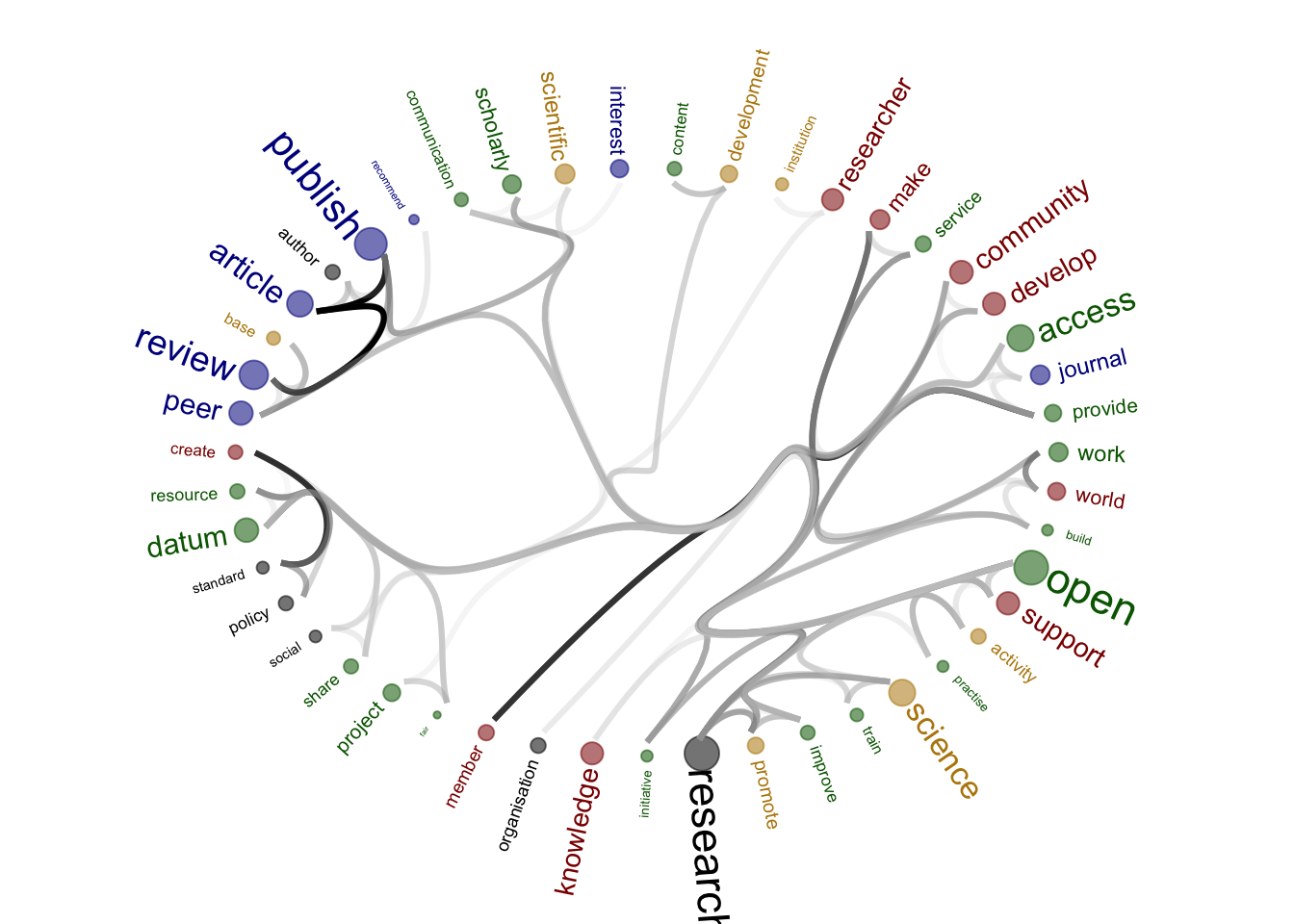
| Version | Author | Date |
|---|---|---|
| 8b3a598 | zuzannazagrodzka | 2023-11-10 |
[1] 32 32
[1] "funders"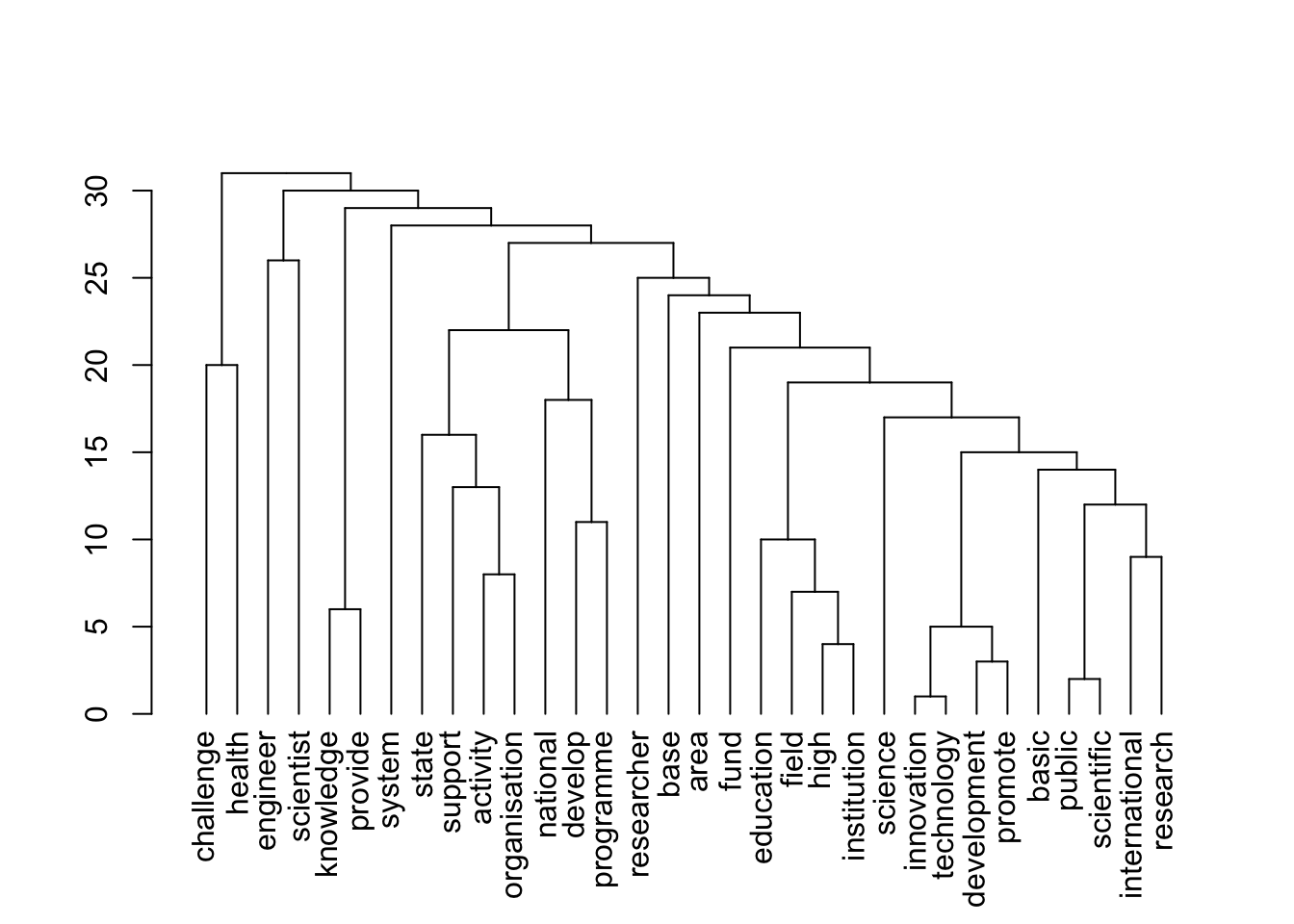
| Version | Author | Date |
|---|---|---|
| 8b3a598 | zuzannazagrodzka | 2023-11-10 |
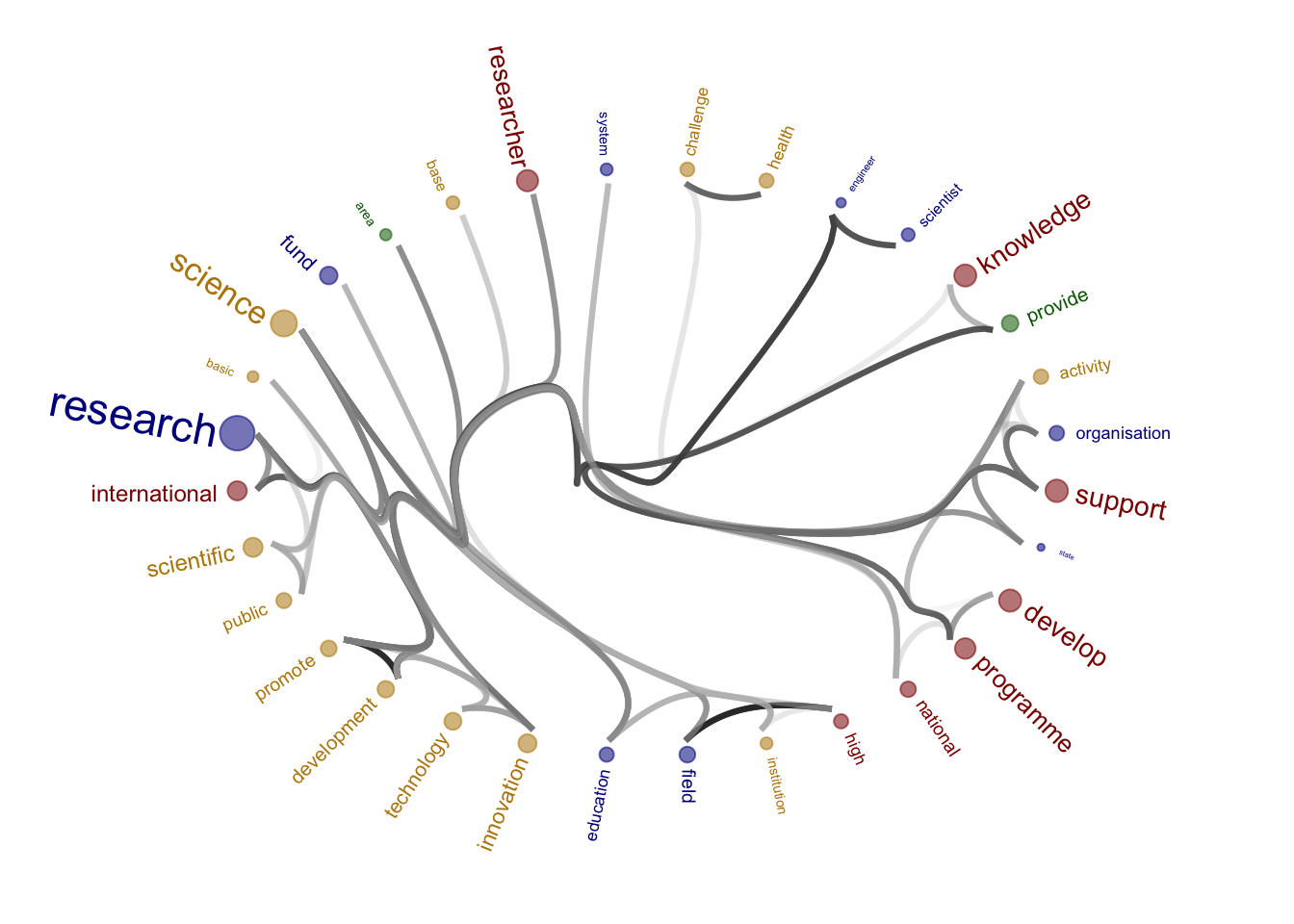
| Version | Author | Date |
|---|---|---|
| 8b3a598 | zuzannazagrodzka | 2023-11-10 |
[1] 39 39
[1] "journals"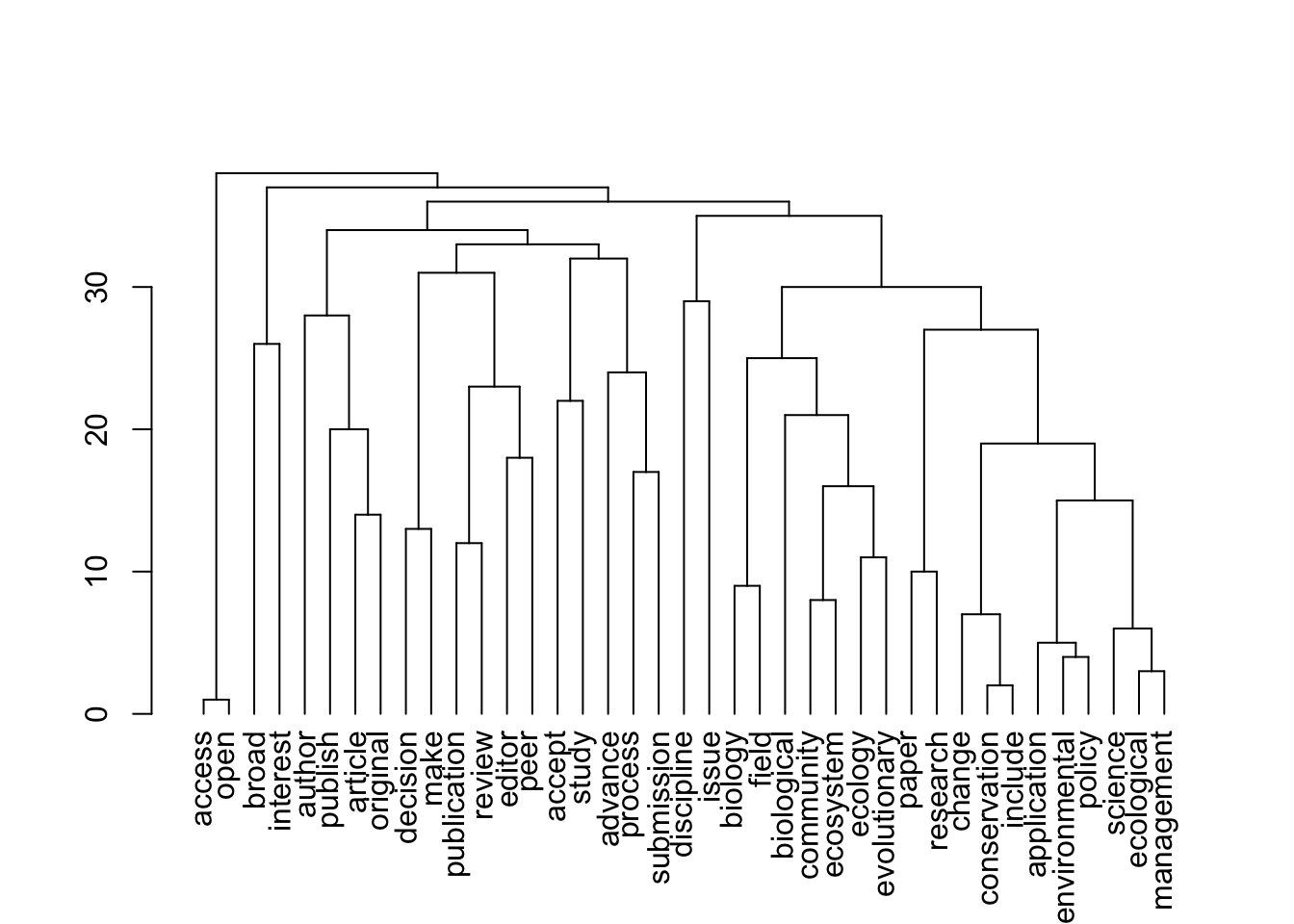
| Version | Author | Date |
|---|---|---|
| 8b3a598 | zuzannazagrodzka | 2023-11-10 |
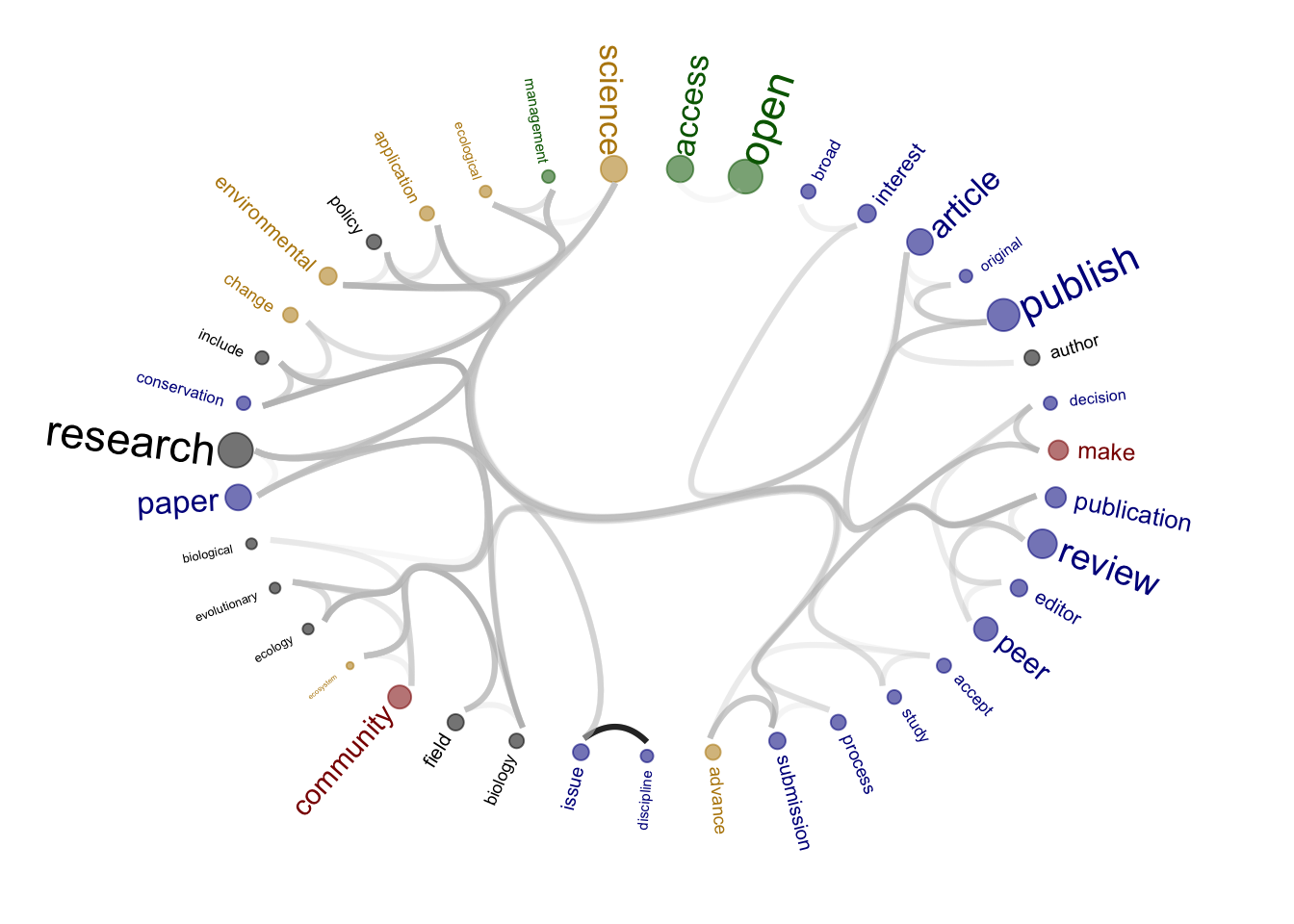
| Version | Author | Date |
|---|---|---|
| 8b3a598 | zuzannazagrodzka | 2023-11-10 |
[1] 48 48
[1] "publishers"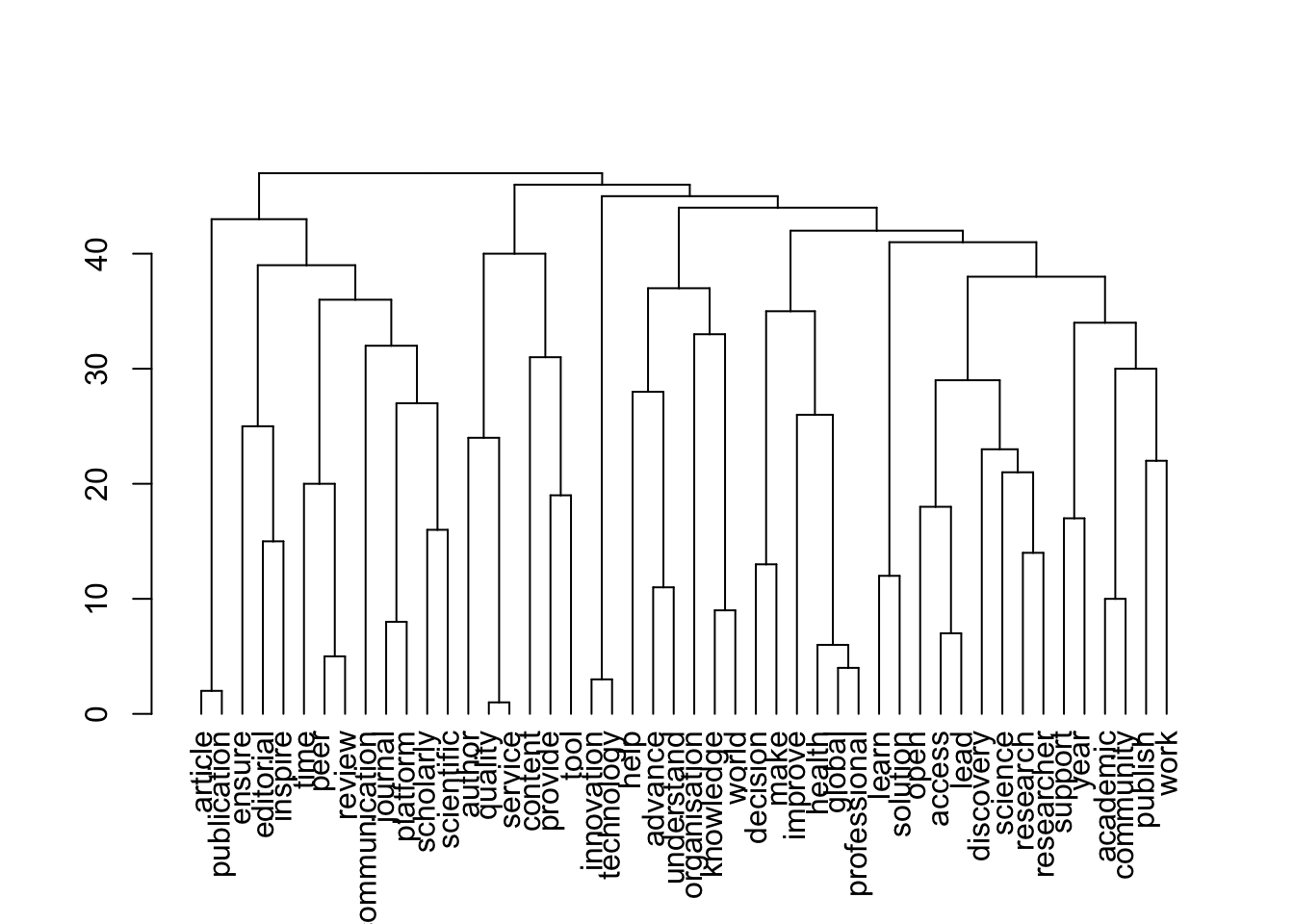
| Version | Author | Date |
|---|---|---|
| 8b3a598 | zuzannazagrodzka | 2023-11-10 |
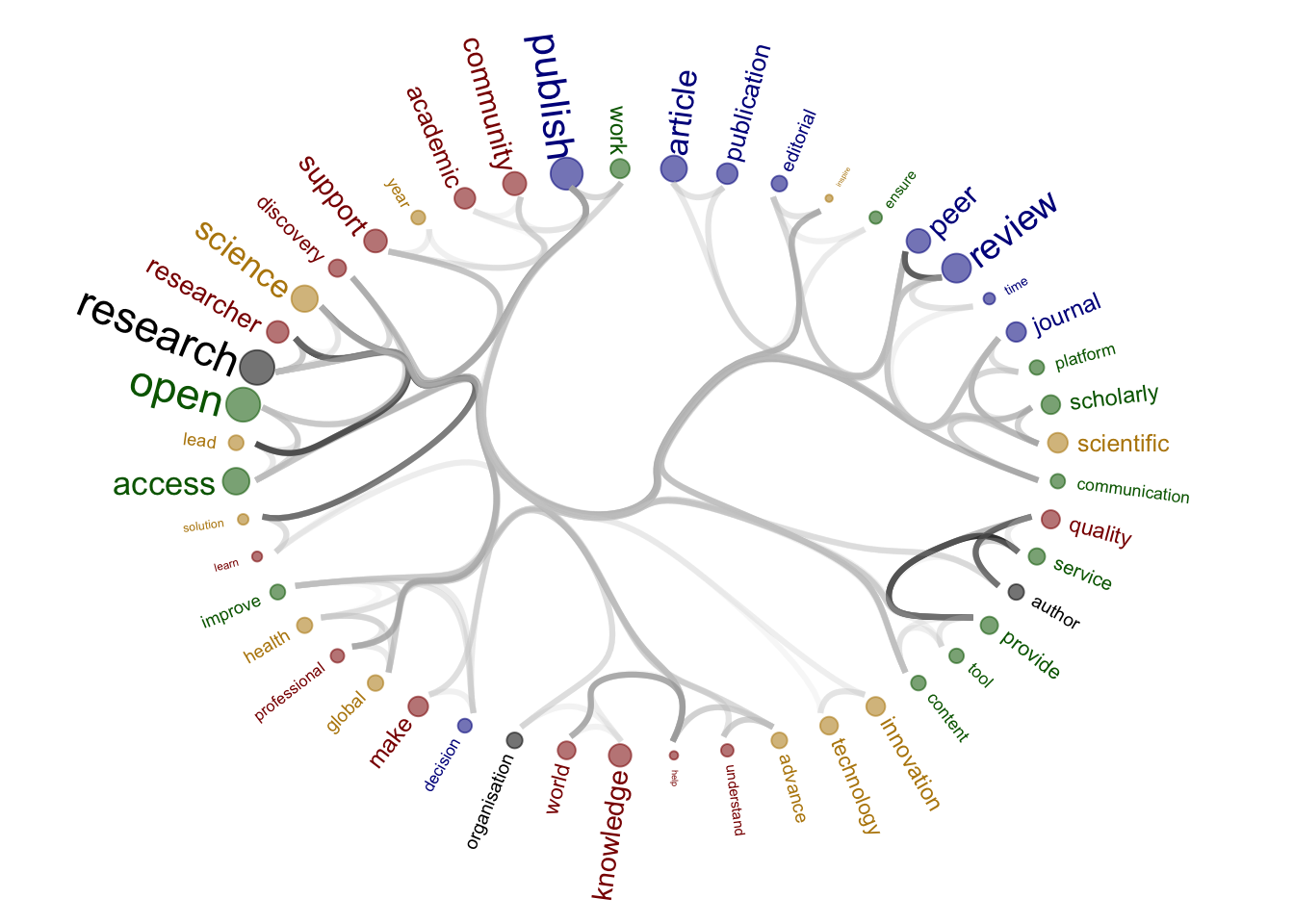
| Version | Author | Date |
|---|---|---|
| 8b3a598 | zuzannazagrodzka | 2023-11-10 |
[1] 35 35
[1] "repositories"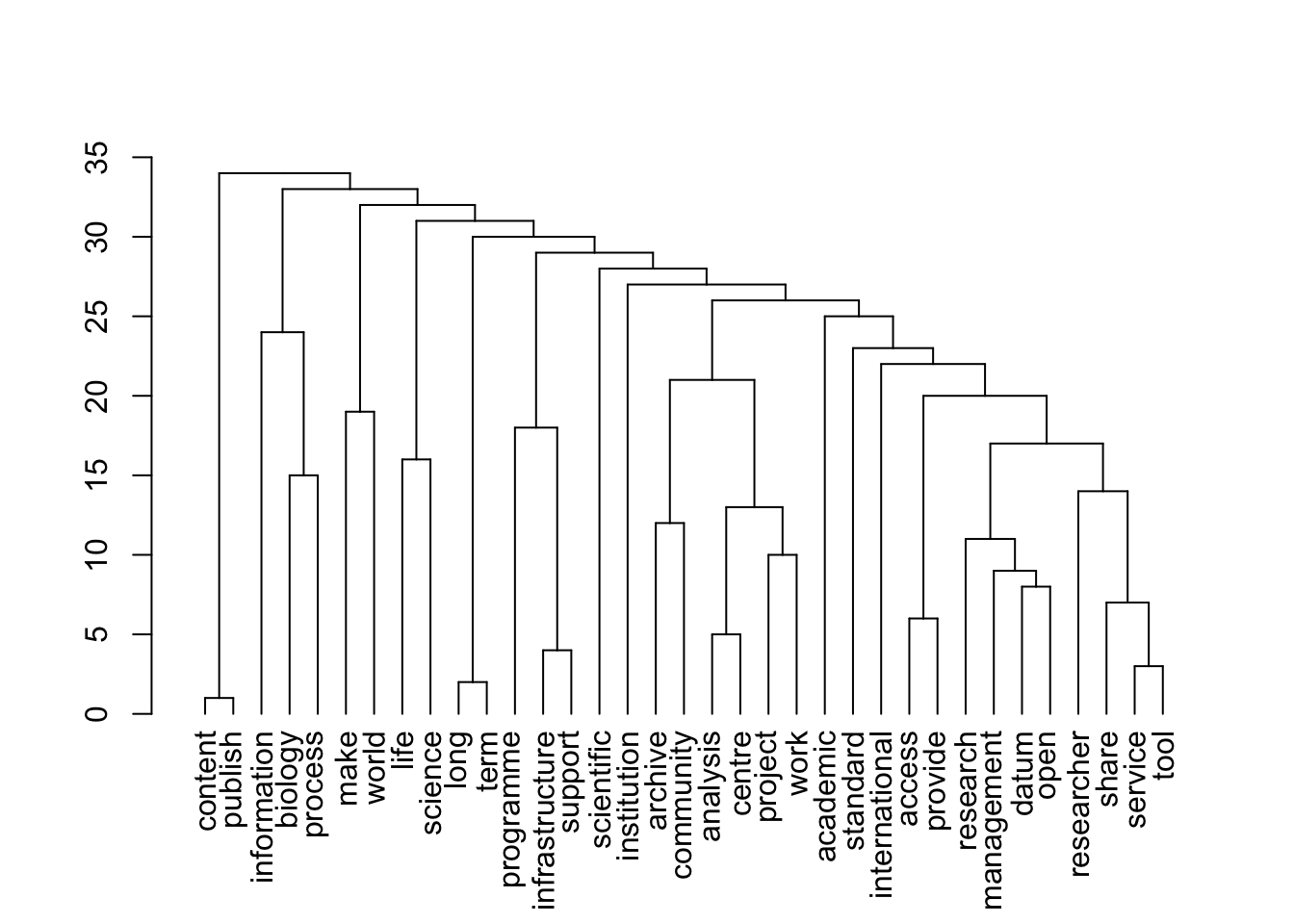
| Version | Author | Date |
|---|---|---|
| 8b3a598 | zuzannazagrodzka | 2023-11-10 |
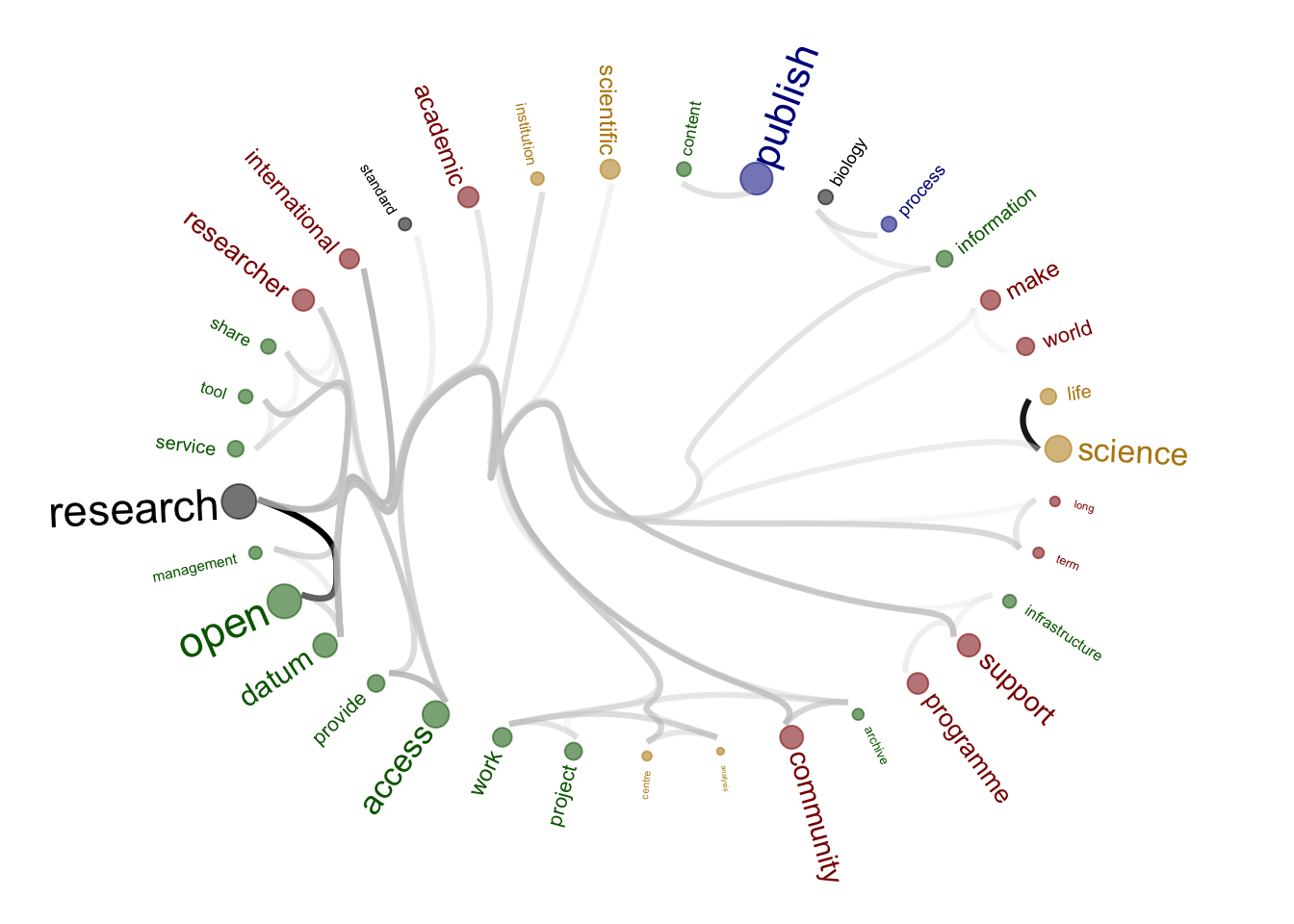
| Version | Author | Date |
|---|---|---|
| 8b3a598 | zuzannazagrodzka | 2023-11-10 |
[1] 34 34
[1] "societies"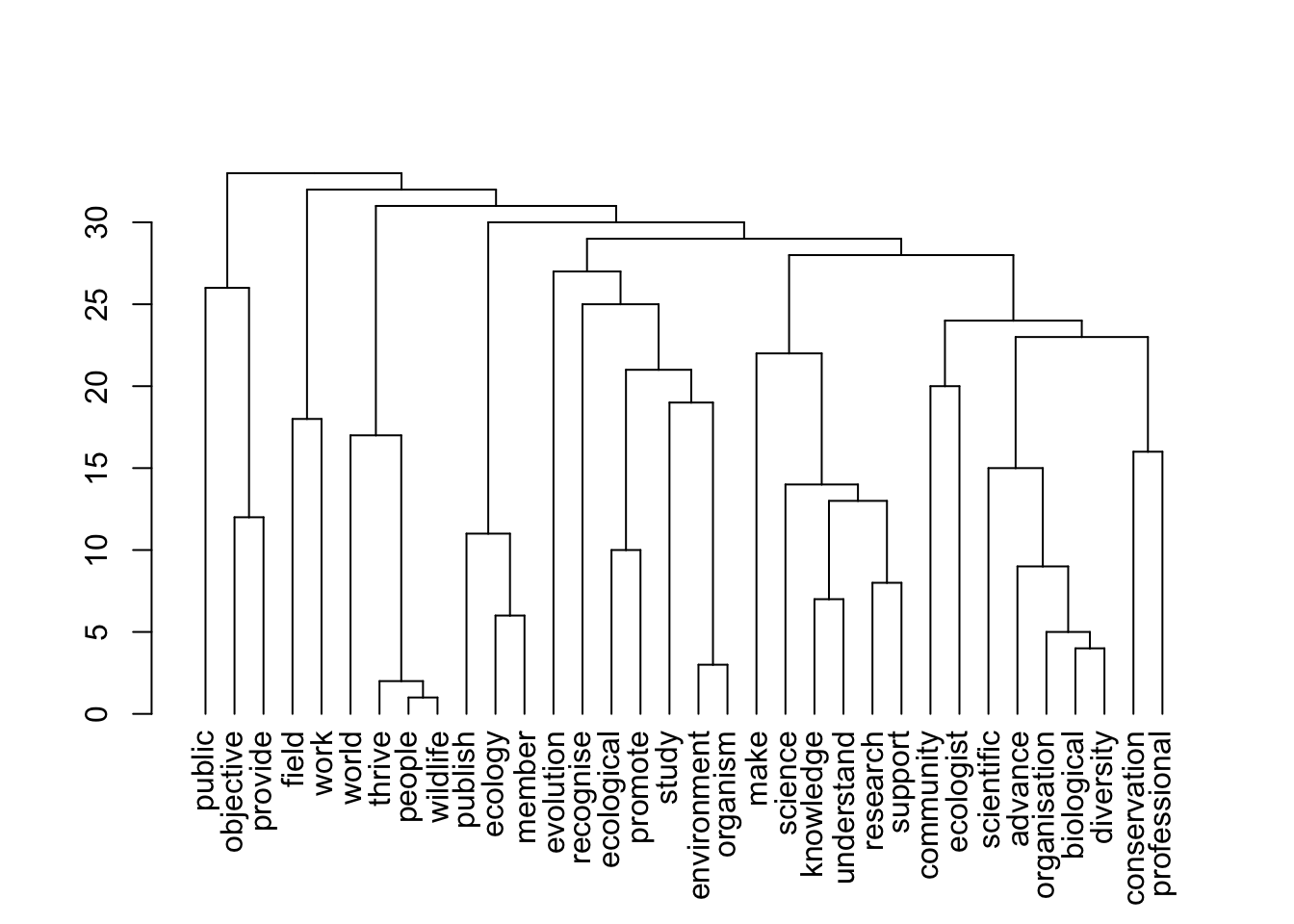
| Version | Author | Date |
|---|---|---|
| 8b3a598 | zuzannazagrodzka | 2023-11-10 |
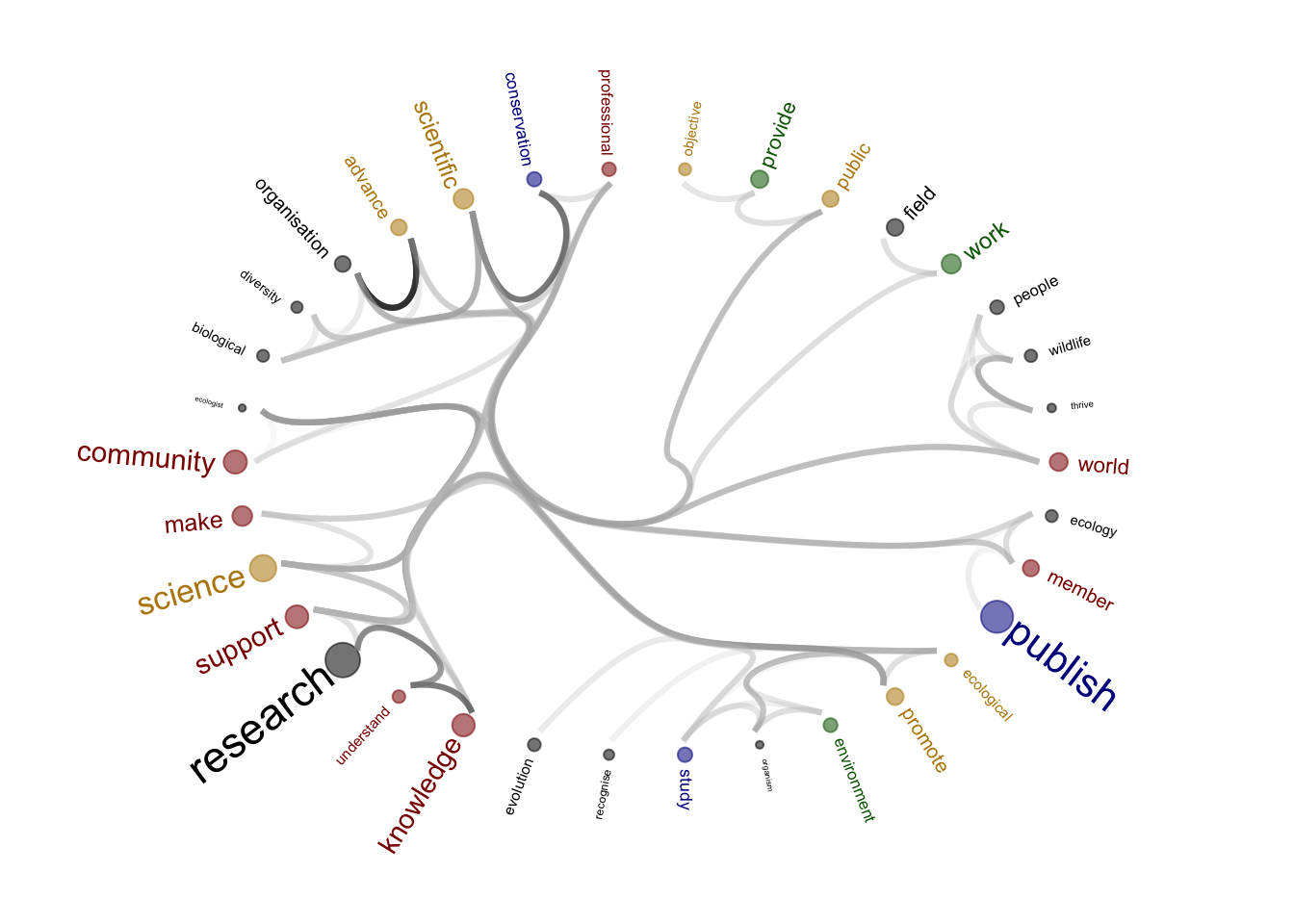
| Version | Author | Date |
|---|---|---|
| 8b3a598 | zuzannazagrodzka | 2023-11-10 |
Figure production
# Saving figures individually
figure_list
figure_name <- paste0("./output/Figure_2B/advocates_5topics_figure2B.png")
png(file=figure_name,
width= 3000, height= 3000, res=400)
advocates_figure2B
dev.off()
figure_name <- paste0("./output/Figure_2B/funders_5topics_figure2B.png")
png(file=figure_name,
width= 3000, height= 3000, res=400)
funders_figure2B
dev.off()
figure_name <- paste0("./output/Figure_2B/journals_5topics_figure2B.png")
png(file=figure_name,
width= 3000, height= 3000, res=400)
journals_figure2B
dev.off()
figure_name <- paste0("./output/Figure_2B/publishers_5topics_figure2B.png")
png(file=figure_name,
width= 3000, height= 3000, res=400)
publishers_figure2B
dev.off()
figure_name <- paste0("./output/Figure_2B/repositories_5topics_figure2B.png")
png(file=figure_name,
width= 3000, height= 3000, res=400)
repositories_figure2B
dev.off()
figure_name <- paste0("./output/Figure_2B/societies_5topics_figure2B.png")
png(file=figure_name,
width= 3000, height= 3000, res=400)
societies_figure2B
dev.off()Additional analysis
Circular graph created on all documents (all stakeholders)
# selecting data with the right name of the stakeholder
dat <- corpus_df %>%
select(sentence_doc, word) %>%
rename(id = sentence_doc)
# Calculating similarity matrix
cos_mat <- cosine_matrix(dat, lower = 0.035, upper = 1, filt = 0.9)
# Getting words used in the network
word_list_net <- rownames(cos_mat)
grep("workflow", word_list_net)integer(0)# Creating a graph
g <- graph_from_adjacency_matrix(cos_mat, mode = "undirected", weighted = TRUE)
topics = walktrap_topics(g)
plot(topics$dendrogram)
| Version | Author | Date |
|---|---|---|
| 8b3a598 | zuzannazagrodzka | 2023-11-10 |
subtrees <- partition_leaves(topics$dendrogram)
leaves <- subtrees[[1]]
pathRoutes <- function(leaf) {
which(sapply(subtrees, function(x) leaf %in% x))
}
paths <- lapply(leaves, pathRoutes)
edges = NULL
for(a in 1:length(paths)){
# print(a)
for(b in c(1:(length(paths[[a]])-1))){
if(b == (length(paths[[a]])-1)){
tmp_df = data.frame(
from = paths[[a]][b],
to = leaves[a]
)
} else {
tmp_df = data.frame(
from = paths[[a]][b],
to = paths[[a]][b+1]
)
}
edges = rbind(edges, tmp_df)
}
}
connect = melt(cos_mat)
colnames(connect) = c("from", "to", "value")
connect = subset(connect, value != 0)
# create a vertices data.frame. One line per object of our hierarchy
vertices <- data.frame(
name = unique(c(as.character(edges$from), as.character(edges$to)))
)
# Let's add a column with the group of each name. It will be useful later to color points
vertices$group <- edges$from[ match( vertices$name, edges$to ) ]
#Let's add information concerning the label we are going to add: angle, horizontal adjustement and potential flip
#calculate the ANGLE of the labels
#vertices$id <- NA
#myleaves <- which(is.na( match(vertices$name, edges$from) ))
#nleaves <- length(myleaves)
#vertices$id[ myleaves ] <- seq(1:nleaves)
#vertices$angle <- 90 - 360 * vertices$id / nleaves
# calculate the alignment of labels: right or left
# If I am on the left part of the plot, my labels have currently an angle < -90
#vertices$hjust <- ifelse( vertices$angle < -90, 1, 0)
# flip angle BY to make them readable
#vertices$angle <- ifelse(vertices$angle < -90, vertices$angle+180, vertices$angle)
# replacing "group" value with the topic numer from the STM
# Colour words by topic modelling topics (STM)
# I have to change the group numbers in topics
stm_top <- corpus_df %>%
select(word, topic = topic)
stm_top$topic <- as.factor(stm_top$topic)
stm_top <- unique(stm_top)
# Removing group column and creating a new one based on the stm info
vertices <- vertices
vertices <- vertices %>%
left_join(stm_top, by = c("name" = "word")) %>%
select(-group) %>%
rename(group = topic)
# Adding a beta value so I can use it in the graph
stm_beta <- corpus_df %>%
select(word, beta = highest_mean_beta)
stm_beta <- unique(stm_beta)
dim(stm_beta)[1] 2832 2vertices <- vertices %>%
left_join(stm_beta, by = c("name" = "word"))
vertices$beta_size = vertices$beta
##########################################################
# Create a graph object
mygraph <- igraph::graph_from_data_frame(edges, vertices=vertices)
# The connection object must refer to the ids of the leaves:
from <- match( connect$from, vertices$name)
to <- match( connect$to, vertices$name)
# Basic usual argument
tmp_plt = ggraph(mygraph, layout = 'dendrogram', circular = T) +
geom_node_point(aes(filter = leaf, x = x*1.05, y=y*1.05, alpha=0.2), size =0, colour = "white") +
#colour=group, size=value
scale_colour_manual(values= c("dark green", "dark red", "darkgoldenrod", "dark blue", "black"), na.value = "black") +
geom_conn_bundle(data = get_con(from = from, to = to, col = connect$value), tension = 0.9, aes(colour = col, alpha = col+0.5), width = 1.1) +
scale_edge_color_continuous(low="white", high="black") +
# geom_node_text(aes(x = x*1.1, y=y*1.1, filter = leaf, label=name, angle = angle, hjust=hjust), size=5, alpha=1) +
geom_node_text(aes(x = x*1.1, y=y*1.1, filter = leaf, label=name, colour = group, angle = 0, hjust = 0.5, size = beta_size), alpha=1) +
theme_void() +
theme(
legend.position="none",
plot.margin=unit(c(0,0,0,0),"cm"),
) +
expand_limits(x = c(-1.5, 1.5), y = c(-1.5, 1.5))
g <- ggplot_build(tmp_plt)
tmp_dat = g[[3]]$data
tmp_dat$position = NA
tmp_dat_a = subset(tmp_dat, x >= 0)
tmp_dat_a = tmp_dat_a[order(-tmp_dat_a$y),]
tmp_dat_a = subset(tmp_dat_a, !is.na(beta))
tmp_dat_a$order = 1:nrow(tmp_dat_a)
tmp_dat_b = subset(tmp_dat, x < 0)
tmp_dat_b = tmp_dat_b[order(-tmp_dat_b$y),]
tmp_dat_b = subset(tmp_dat_b, !is.na(beta))
tmp_dat_b$order = (nrow(tmp_dat_a) +nrow(tmp_dat_b)) : (nrow(tmp_dat_a) +1)
tmp_dat = rbind(tmp_dat_a, tmp_dat_b)
vertices = left_join(vertices, tmp_dat[,c("name", "order")], by = c("name"))
vert_save = vertices
vertices = vert_save
vertices$id <- NA
vertices = vertices[order(vertices$order),]
myleaves <- which(is.na( match(vertices$name, edges$from) ))
nleaves <- length(myleaves)
vertices$id[ myleaves ] <- seq(1:nleaves)
vertices$angle <- 90 - 360 * vertices$id / nleaves
# calculate the alignment of labels: right or left
# If I am on the left part of the plot, my labels have currently an angle < -90
vertices$hjust <- ifelse( vertices$angle < -90, 1, 0)
# flip angle BY to make them readable
vertices$angle <- ifelse(vertices$angle < -90, vertices$angle+180, vertices$angle)
vertices = vertices[order(as.numeric(rownames(vertices))),]
mygraph <- igraph::graph_from_data_frame(edges, vertices=vertices)
figure_tosave <- ggraph(mygraph, layout = 'dendrogram', circular = T) +
geom_node_point(aes(filter = leaf, x = x*1.05, y=y*1.05, alpha=0.2, colour = group, size = beta_size)) +
#colour=group, size=value
scale_colour_manual(values= c("dark green", "dark red", "darkgoldenrod", "dark blue", "black"), na.value = "black") +
geom_conn_bundle(data = get_con(from = from, to = to, col = connect$value), tension = 0.99, aes(colour = col, alpha = col+0.5), width = 1.1) +
scale_edge_color_continuous(low="grey90", high="black") +
geom_node_text(aes(x = x*1.1, y=y*1.1, filter = leaf, label=name, colour = group, angle = angle, hjust = hjust, size = beta_size)) +
theme_void() +
theme(
legend.position="none",
plot.margin=unit(c(0,0,0,0),"cm"),
) +
expand_limits(x = c(-1.6, 1.6), y = c(-1.6, 1.6))
figure_name <- paste0("./output/Other_figures/All_stakeholders_5topics_figure.png")
# uncomment to generate file
# png(file=figure_name,
# width=3000, height=3000, res = 500)
# figure_tosave
# dev.off()
# figure_tosaveSession information
sessionInfo()R version 4.3.1 (2023-06-16)
Platform: x86_64-apple-darwin20 (64-bit)
Running under: macOS Monterey 12.6
Matrix products: default
BLAS: /Library/Frameworks/R.framework/Versions/4.3-x86_64/Resources/lib/libRblas.0.dylib
LAPACK: /Library/Frameworks/R.framework/Versions/4.3-x86_64/Resources/lib/libRlapack.dylib; LAPACK version 3.11.0
locale:
[1] en_US.UTF-8/en_US.UTF-8/en_US.UTF-8/C/en_US.UTF-8/en_US.UTF-8
time zone: Europe/London
tzcode source: internal
attached base packages:
[1] stats graphics grDevices utils datasets methods base
other attached packages:
[1] arrow_13.0.0.1 tidytext_0.4.1 lubridate_1.9.3 forcats_1.0.0
[5] stringr_1.5.0 purrr_1.0.2 readr_2.1.4 tidyr_1.3.0
[9] tibble_3.2.1 tidyverse_2.0.0 dplyr_1.1.3 reshape2_1.4.4
[13] ggraph_2.1.0 ggplot2_3.4.3 igraph_1.5.1 dendextend_1.17.1
[17] workflowr_1.7.1
loaded via a namespace (and not attached):
[1] gtable_0.3.4 xfun_0.40 bslib_0.5.1 processx_3.8.2
[5] ggrepel_0.9.4 lattice_0.21-8 tzdb_0.4.0 callr_3.7.3
[9] vctrs_0.6.3 tools_4.3.1 ps_1.7.5 generics_0.1.3
[13] fansi_1.0.4 janeaustenr_1.0.0 tokenizers_0.3.0 pkgconfig_2.0.3
[17] Matrix_1.5-4.1 assertthat_0.2.1 lifecycle_1.0.3 compiler_4.3.1
[21] farver_2.1.1 git2r_0.32.0 munsell_0.5.0 lsa_0.73.3
[25] ggforce_0.4.1 getPass_0.2-2 graphlayouts_1.0.2 httpuv_1.6.11
[29] SnowballC_0.7.1 htmltools_0.5.6 sass_0.4.7 yaml_2.3.7
[33] crayon_1.5.2 later_1.3.1 pillar_1.9.0 jquerylib_0.1.4
[37] whisker_0.4.1 MASS_7.3-60 cachem_1.0.8 viridis_0.6.4
[41] tidyselect_1.2.0 digest_0.6.33 stringi_1.7.12 labeling_0.4.3
[45] polyclip_1.10-6 rprojroot_2.0.3 fastmap_1.1.1 grid_4.3.1
[49] colorspace_2.1-0 cli_3.6.1 magrittr_2.0.3 tidygraph_1.2.3
[53] utf8_1.2.3 withr_2.5.1 scales_1.2.1 promises_1.2.1
[57] bit64_4.0.5 timechange_0.2.0 rmarkdown_2.25 httr_1.4.7
[61] bit_4.0.5 gridExtra_2.3 hms_1.1.3 evaluate_0.21
[65] knitr_1.44 viridisLite_0.4.2 rlang_1.1.1 Rcpp_1.0.11
[69] glue_1.6.2 tweenr_2.0.2 rstudioapi_0.15.0 jsonlite_1.8.7
[73] R6_2.5.1 plyr_1.8.9 fs_1.6.3
sessionInfo()R version 4.3.1 (2023-06-16)
Platform: x86_64-apple-darwin20 (64-bit)
Running under: macOS Monterey 12.6
Matrix products: default
BLAS: /Library/Frameworks/R.framework/Versions/4.3-x86_64/Resources/lib/libRblas.0.dylib
LAPACK: /Library/Frameworks/R.framework/Versions/4.3-x86_64/Resources/lib/libRlapack.dylib; LAPACK version 3.11.0
locale:
[1] en_US.UTF-8/en_US.UTF-8/en_US.UTF-8/C/en_US.UTF-8/en_US.UTF-8
time zone: Europe/London
tzcode source: internal
attached base packages:
[1] stats graphics grDevices utils datasets methods base
other attached packages:
[1] arrow_13.0.0.1 tidytext_0.4.1 lubridate_1.9.3 forcats_1.0.0
[5] stringr_1.5.0 purrr_1.0.2 readr_2.1.4 tidyr_1.3.0
[9] tibble_3.2.1 tidyverse_2.0.0 dplyr_1.1.3 reshape2_1.4.4
[13] ggraph_2.1.0 ggplot2_3.4.3 igraph_1.5.1 dendextend_1.17.1
[17] workflowr_1.7.1
loaded via a namespace (and not attached):
[1] gtable_0.3.4 xfun_0.40 bslib_0.5.1 processx_3.8.2
[5] ggrepel_0.9.4 lattice_0.21-8 tzdb_0.4.0 callr_3.7.3
[9] vctrs_0.6.3 tools_4.3.1 ps_1.7.5 generics_0.1.3
[13] fansi_1.0.4 janeaustenr_1.0.0 tokenizers_0.3.0 pkgconfig_2.0.3
[17] Matrix_1.5-4.1 assertthat_0.2.1 lifecycle_1.0.3 compiler_4.3.1
[21] farver_2.1.1 git2r_0.32.0 munsell_0.5.0 lsa_0.73.3
[25] ggforce_0.4.1 getPass_0.2-2 graphlayouts_1.0.2 httpuv_1.6.11
[29] SnowballC_0.7.1 htmltools_0.5.6 sass_0.4.7 yaml_2.3.7
[33] crayon_1.5.2 later_1.3.1 pillar_1.9.0 jquerylib_0.1.4
[37] whisker_0.4.1 MASS_7.3-60 cachem_1.0.8 viridis_0.6.4
[41] tidyselect_1.2.0 digest_0.6.33 stringi_1.7.12 labeling_0.4.3
[45] polyclip_1.10-6 rprojroot_2.0.3 fastmap_1.1.1 grid_4.3.1
[49] colorspace_2.1-0 cli_3.6.1 magrittr_2.0.3 tidygraph_1.2.3
[53] utf8_1.2.3 withr_2.5.1 scales_1.2.1 promises_1.2.1
[57] bit64_4.0.5 timechange_0.2.0 rmarkdown_2.25 httr_1.4.7
[61] bit_4.0.5 gridExtra_2.3 hms_1.1.3 evaluate_0.21
[65] knitr_1.44 viridisLite_0.4.2 rlang_1.1.1 Rcpp_1.0.11
[69] glue_1.6.2 tweenr_2.0.2 rstudioapi_0.15.0 jsonlite_1.8.7
[73] R6_2.5.1 plyr_1.8.9 fs_1.6.3